Here at Arousing Appetites we can think of no better way of bringing in the lunar new year than hitting the kitchen. This week, our taste buds turn to Vietnam’s new year specialty: banh chung, the square-shaped rice cake parcels filled with mung beans and pork.
Têt – short for Têt Nguyen Dan – is the Vietnamese term for the lunar new year and is a big holiday in the country. Shortened from the historical three-month hiatus between agricultural cycles, Têt celebrations can still span up to 18 days.
During this time, folks get together with their families, go visit other friends and families, remember their dead, decorate their houses with kumquat trees and peach blossom, and, most importantly, cook.
With so many visitors coming and going from the house, the new year’s spread needs to be hefty. Traditional dishes such as boiled chicken, pickled shallots and candied fruit are rolled out to be enjoyed, but Têt would not be Têt without a shedload of banh chung in the mix.

TEAMWORK MAKES THE BANH CHUNG DREAM WORK
It takes a village to raise a child, and it takes a family to make banh chung. Not for the impatient or those short on time, the process of wrapping the rice cakes and then steaming them for hours is usually overseen by several people, and is an integral part of the new year’s festivities.
Some households have a giant pot in which the banh chung cooks overnight and it’s common for the family to gather around and spend the night around the pot, though we’d like to make it clear that making our banh chung recipe will not necessitate actually sleeping in your kitchen. And if you have an Instant Pot (on Amazon) or a slow cooker (on Amazon), the process can be much easier.
You May Also Like
If you appreciate different cultures celebrating New Year, you might also want to check out the Scottish Steak Pie – it’s made with a dark ale and puff pastry, do we really need to say more? Or you can check out how the Koreans celebrate their new year with a spicy vegan rice cake soup.
MY KINGDOM FOR BANH CHUNG
Banh chung’s origins can be traced way back to a book called the Lĩnh Nam chích quái, a compilation of stories from 14th century Vietnam where an anonymous author tells the tale of how banh chung came to be: King Hung Vuong VI of the Hong Bang Dynasty couldn’t decide which of his 20 sons should assume the throne after his death. So he decided to give them a test. They were to go out into the world and bring back the most exotic, the most enticing food that would also make for a worthy offering to the ancestors’ altar.
The children scuttled off and came back with all manner of curious comestibles such as bears’ paws, rhinoceros’ livers, monkeys’ brains, orangutans’ lips, phoenix meat and peacock sausages. But his 18th son, Tiêt Liêu, who was not so wealthy and didn’t have the means to travel far, had a dream in which a deity appeared to him and suggested using what was right under his nose – rice.
Nutritious and filling, he suggested wrapping the glutinous variety of rice in leaves – one in a square shape to represent the earth and the other in a cylindrical form to stand for the sky. The kerfuffle of the wrapping, the deity told him, would be an excellent homage to the pain his parents and ancestors went through in order to bring him into the world.
His father was very taken by the dishes that Tiêt Liêu had prepared, and was touched by their significance. He declared his rice-cake making son to be the winner and named him his heir.

GLUTINOUS RICE WRAPS TO USHER IN THE YEAR OF THE DOG
Here at Arousing Appetites we can think of no better way of bringing in the lunar new year than hitting the kitchen. This week, our taste buds turn to Vietnam’s new year specialty: banh chung, the square-shaped rice cake parcels filled with mung beans and pork.
Têt – short for Têt Nguyen Dan – is the Vietnamese term for the lunar new year and is a big holiday in the country. Shortened from the historical three-month hiatus between agricultural cycles, Têt celebrations can still span up to 18 days.
During this time, folks get together with their families, go visit other friends and families, remember their dead, decorate their houses with kumquat trees and peach blossom, and, most importantly, cook.
With so many visitors coming and going from the house, the new year’s spread needs to be hefty. Traditional dishes such as boiled chicken, pickled shallots and candied fruit are rolled out to be enjoyed, but Têt would not be Têt without a shedload of banh chung in the mix.

The children scuttled off and came back with all manner of curious comestibles such as bears’ paws, rhinoceros’ livers, monkeys’ brains, orangutans’ lips, phoenix meat and peacock sausages. But his 18th son, Tiêt Liêu, who was not so wealthy and didn’t have the means to travel far, had a dream in which a deity appeared to him and suggested using what was right under his nose – rice.
Nutritious and filling, he suggested wrapping the glutinous variety of rice in leaves – one in a square shape to represent the earth and the other in a cylindrical form to stand for the sky. The kerfuffle of the wrapping, the deity told him, would be an excellent homage to the pain his parents and ancestors went through in order to bring him into the world.
His father was very taken by the dishes that Tiêt Liêu had prepared, and was touched by their significance. He declared his rice-cake making son to be the winner and named him his heir.
The Staple of Rice in Vietnamese Cuisine
Glutinous rice exists alongside regular rice in Vietnam and has been a staple there since at least the 10th century. Its primary use is in steamed rice cakes, but it’s also used in making sweetened porridges and pickles, as well as drinks like ruou cân, a beer ingested through long bamboo tubes.
What’s great about banh chung is that, once cooked, it is sturdy and long-lasting. Supposedly the shallots add to their longevity. It’s traditional to cut them with the twine used to hold the parcels together, then to place the cakes onto the family altar as an offering to ancestors. So integral are banh chung to the Têt traditions that in some poorer villages special banks or kinship groups called ho banh chung are set up in order to ensure that a bad financial year won’t ruin a family’s prospects of having banh chung for Têt.
ABOUT THE RECIPE
If you’re not in the mood for eating pork, or if you don’t eat meat, rest easy in the knowledge that there are plenty of variations of banh chung to consider: Buddhist vegetarians eat banh chung chay with no meat inside, while there is a sweeter variation called banh chung ngot that contains brown sugar and fibrous coconut flesh. There’s also a version of banh chung with a hump called banh chung gu, eaten by the San Diu people. Not so fresh banh chung can be reinvigorated with a bit of oil in the skillet to make banh chung ran while a different, cylindrical version of the rice cake is called banh tet. The list goes on.
DON’T FEAR THE WRAPPING
So you’ve never made rice wrapped in banana leaves before. We understand it’s an intimidating prospect; in fact, we scoured the web for tips and even found some more perfectionist banh chung makers laying out their leaves with the help of a wooden frame. Take your time and don’t worry too much about getting the square just so. The most important point is that the parcel is wrapped tight and won’t leak.
And if you really become enraged with your banh chung wrapping, spare a thought for the team of 50 people who participated in making a 2.5 ton banh chung in Dam Sen Cultural Park in Ho Chi Minh back in 2013. The rice cake was so large it had to be hoisted into an enormous vat of boiling water using a pulley system, and it took several days to cook.
Traditionally in Vietnam, la giong leaves are used to wrap the banh chung and it’s these leaves that give the rice cakes their characteristic green hue. But these are quite tricky to source in the west, and the humble banana leaf makes an excellent alternative.
PREPARING THE BANH CHUNG FILLING
The first thing you’ll need to do ahead of time is soaking your rice and your mung beans. The absolute minimum amount of time for doing this is eight hours, though we recommend more if at all possible. If you can, get the rice and beans in water the day before, or at least leave them to soak overnight. Also, bear in mind that having glutinous rice for this recipe is essential – other types of rice simply won’t work as they won’t have the required stickiness.

Once the beans have soaked enough, put them in a pot with just enough water to cover them. Heat on medium until the water boils, then let the beans simmer for about half an hour until they are soft enough to be mashed easily.
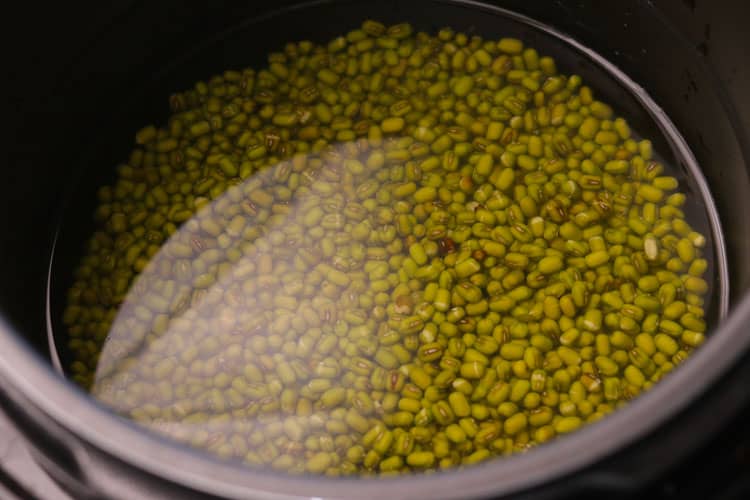
Once you drain the rice, mix in a teaspoon of salt to season it.
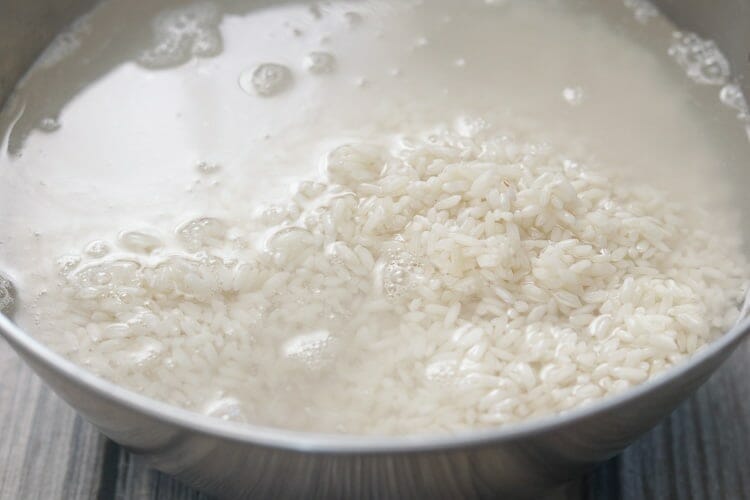
Mix together the pork with the sliced raw shallots, the turmeric powder, and the sliced lemongrass. Add the fish sauce (on Amazon), the liquid smoke and half a teaspoon of pepper.
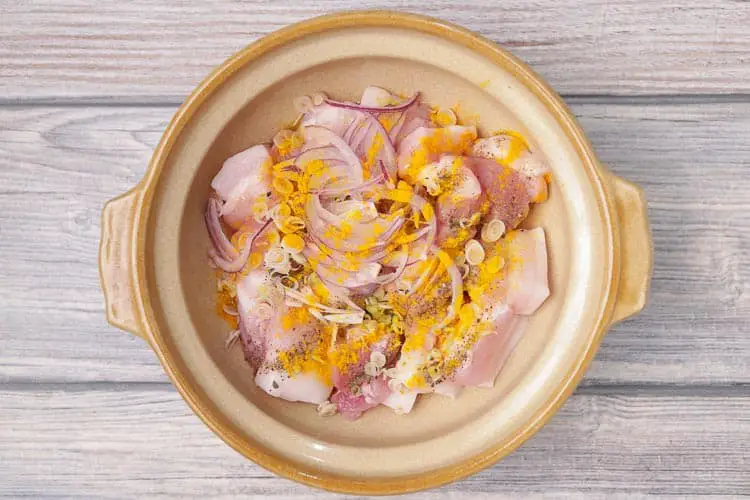
Mash the drained mung beans with a fork, adding half a teaspoon of salt, half a teaspoon of pepper and the sesame oil.
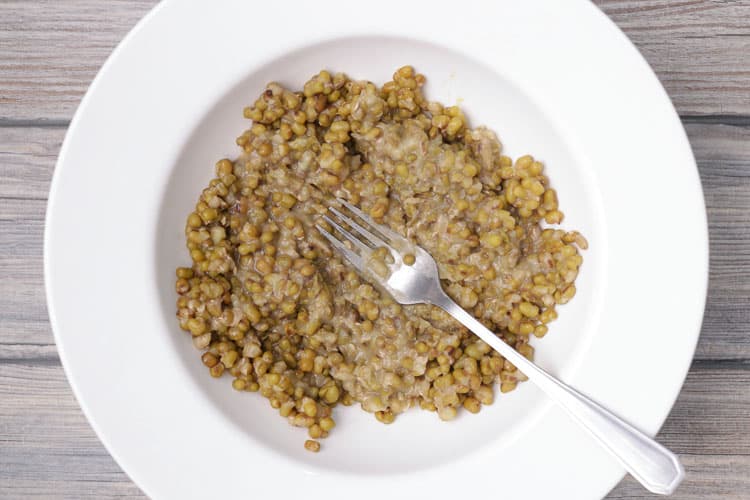
Mash down into a smooth paste and add the fried shallots. And, perhaps, a pinch more salt and pepper to taste.

Lay out a piece of saran wrap and spread out the mung beans into a rough square shape. Now add the pork mixture on top. Try and keep the shape compact as you use the plastic to fold the ingredients into a ball or a cube with pork in the middle and the mashed mung beans on the outside.
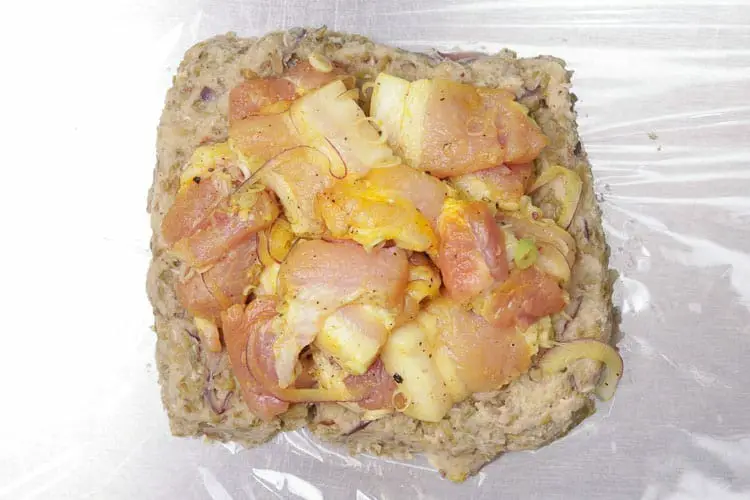
WRAPPING THE BANH CHUNG
Wash and dry your banana leaves. Before you start wrapping, warm them up a little by passing them over an open gas flame on your stove (without charring them!) or over a hot electric burner. This will make them more supple and elastic for the next step. Now lay them with the dark side up, take a cup of your soaked glutinous rice and place in the middle of the top leaf.

Place your bean and pork ball in the middle of the rice. Then cover with another cup of rice.

As if you are wrapping a present, fold in the sides of the banana leaves to make a square of about five inches in length and two inches in depth. Once you have your little parcel, we recommend reinforcing it with another layer of banana leaf. For your second leaf, have the darker side of the leaf facing outwards, and be sure to pack the contents nice and tight so they don’t leak while cooking. Hold the leaves in place with some cooking twine.

COOKING BANH CHUNG
Add your wrapped rice cake to a pot and add water to completely submerge your rice cake. Weight your rice cake down with something heavy to be sure that it remains submerged. Bring to the water to a boil and keep it cooking for six to eight hours. Keep checking the level of the water and be sure to refill with hot water from the kettle once it goes below the level of your package.
Another option here is to cook the banh chung in an Instant Pot (on Amazon), regular pressure cooker or slow cooker (on Amazon). Pressure cooker cooking time should be about three hours, while for slow cookers we recommend following the machine’s instructions and cooking on a soup setting. Either way, the banh chung package should still be submerged in water.

You’ll know your banh chung is ready when the package feels firm and it’s clear that the rice inside has congealed. Take it out of the water and allow it to cool. Brush over the surface with a little oil.
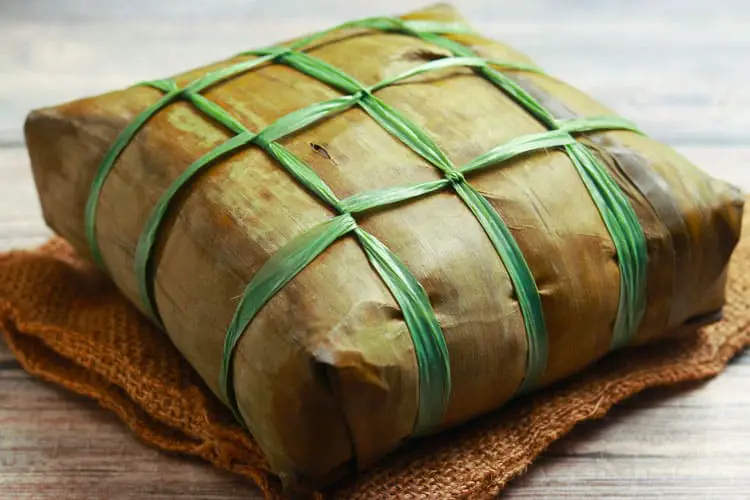
When it has cooled sufficiently, peel off the layers and cut up the cake. A banh chung this size should serve two to four people. You can either use the twine that held the parcel together to cut it, or you could try string or dental floss. A knife might be too cumbersome as the sticky rice tends to adhere to the blade.
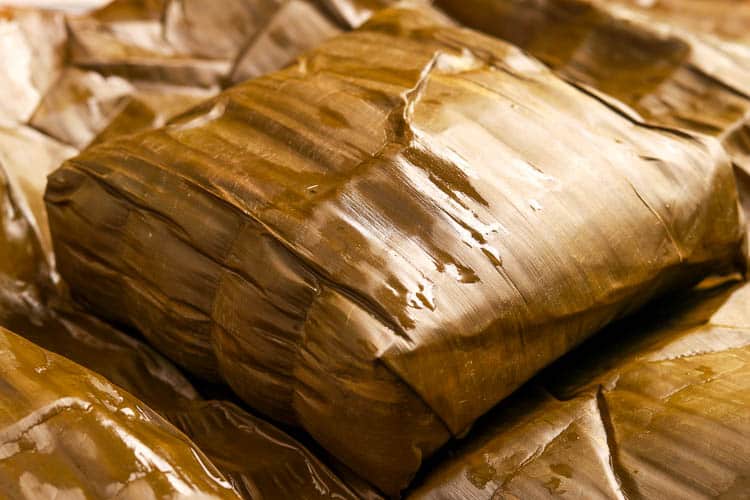
Your banh chung is ready! Serve it on the banana leaf it was cooked it (if it’s still in one piece!) with a side of pickled shallots or pickled vegetables.
Chúc mừng năm mới and ăn nào! Happy new year and bon appetit!
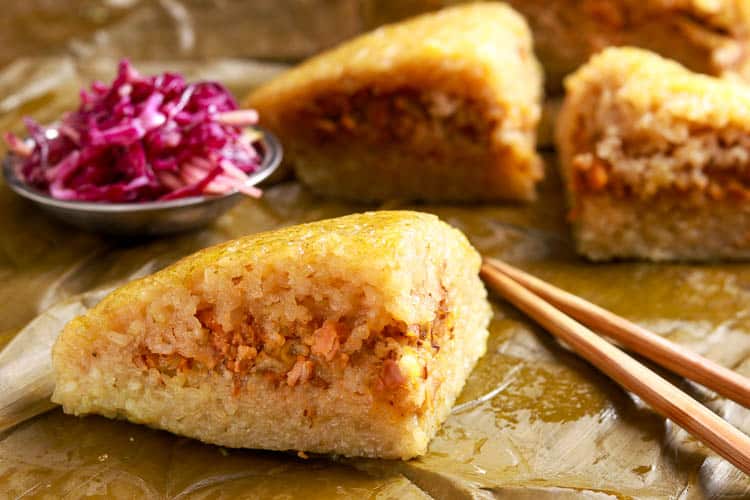
OUR TAKE ON THE RECIPE
After we finished our victory lap of the kitchen upon the successful unwrapping of a well-formed banh chung, we felt like we had opened a window into the joys and satisfaction of steaming glutinous rice. Although, the process was not without potential pitfalls.
We found it essential to pass the banana leaves over a source of heat like a stove’s open flame in order to loosen them up a bit for wrapping. We also found that the rice and pork fillings were easier to work with when cold, so do keep them chilled until you are ready to wrap them.
When wrapping, it’s important to keep the package tight, but not overly so, since the rice does expand during the cooking process. Make the packages snug, but not so tight that they will break when the rice cooks. When you take the leaves out of the pot at the end of the cooking process, they will be very dry and brittle. Brush them with a little oil to keep them supple and prevent them from falling apart.
Outside of its festive attributes, banh chung has revealed itself to us as a very practical and portable food, a kind of rice sandwich perfect for picnics or lunch on the go. Carbs, protein – what more do you need? Its simplicity reminded us of Chinese ma chang and a sweet Philippine version called suman, and we found it to be very aromatic with a perfect spring in every bite.
As we mentioned earlier, our hack for cooking the banh chung was to use the Instant Pot (on Amazon), rather than leaving the stove on for eight hours and running the risk of it drying out, which has happened to us before with dire, pan-destroying consequences. Bear in mind you can also use a regular pressure cooker or a slow cooker (on Amazon) to take away the necessity of having to oversee a steaming pot throughout the day. You could use the same cooker to tenderize the mung beans at the beginning of the recipe, so cutting the time they take to cook in half.
Another idea we had, similar to the method of frying banh chung in oil to give it a bit more of a kick, would be to potentially finish the rice cake off over a charcoal grill to give it more of a smoky flavor. This is what is done in the Philippines with some varieties of suman.
Changes we made from our source recipe involved adding turmeric powder to the pork to give it some more color, some lemongrass slices to brighten up the flavor of the pork and a teaspoon of liquid smoke. The reason we opted for the latter was that the dish actually reminded us of a Hawaiian pork luau (because of the fatty cut of pork and banana leaves), so we wanted to give it that same smoky flavor which the luau gets from pit – but this is an ingredient that you could certainly omit depending on your flavor preferences.
And do remember that you can switch out the pork for pretty much any ingredient you like – we are quite excited about making sweet banh chung ngot with sugar and coconut next time around.
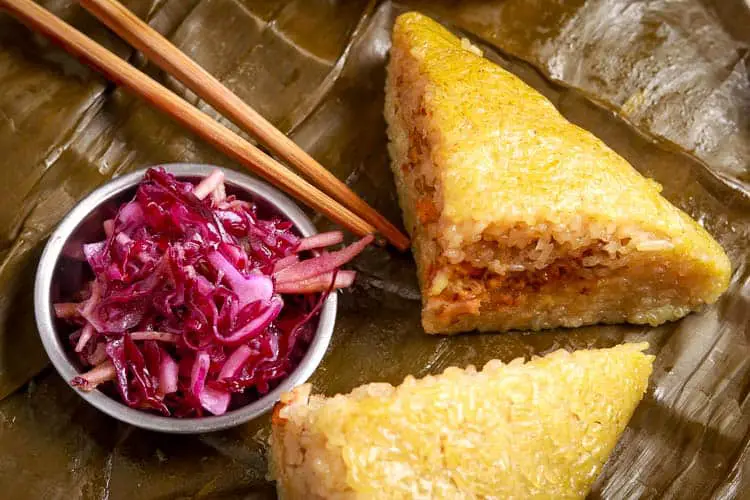
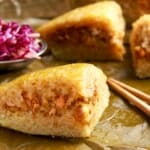
Banh Chung Vietnamese Steamed Rice Cakes
- Total Time: 8 hours
Ingredients
Banh Chung Filling
- 1/2 cup mung beans washed and soaked in water 8 hours
- 2 cups sticky (glutinous) rice washed and soaked in water 8 hours
- 1.5 tsp salt (1 tsp for the rice; .5 tsp for the mung beans)
- 100 grams pork belly cut into cubes
- 1 shallot, sliced
- 1 tsp turmeric powder
- 1 tsp chopped lemongrass
- 1 tbsp fish sauce (on Amazon)
- 1 tsp liquid smoke (optional, depending on flavor preference)
- 1 tsp ground black pepper
- 1 tsp sesame oil
- 1 shallot, sliced and fried
Banh Chung Wrap
- 4 pieces banana leaves
- Cooking twine (for holding the wrap together)
Instructions
Step 1: Prepare the Banh Chung Filling
- Soak the glutinous rice and the mung beans for at least eight hours.
- Drain the soaked mung beans and transfer them into a pot with just enough water to cover them. Cook on a medium heat until the water boils, then let the beans simmer for about half an hour, or until they are soft enough to be mashed easily.
- Drain the soaked rice and add a teaspoon of salt. Stir to combine.
- Mix together the pork with the sliced raw shallots, turmeric powder, sliced lemongrass, fish sauce (on Amazon), liquid smoke and half a teaspoon of pepper to the pork mixture.
- Mash the drained mung beans with a fork, adding half a teaspoon of salt, half a teaspoon of pepper and a glug of sesame oil.
- Continue to mash the mung beans down into a smooth paste and then add the fried shallots. And, maybe just a pinch more salt and pepper to taste.
- Lay out a piece of saran wrap and spread out half the mung bean paste you’ve created into a rough square shape.
- Then, add the pork mixture on top.
- Then, add the remaining mung bean paste on top.
- Use the saran wrap to fold the ingredients into a ball or a cube with pork in the middle and the mashed mung beans on the outside.
Step 2: Wrap the Banh Chung
- Wash and dry your banana leaves.
- Warm up your leaves a little by passing them over an open gas flame on your stove (without charring them!) or over a hot electric burner.
- Lay down one leaf with the dark side up, take a cup of your soaked glutinous rice and place it in the middle of the leaf.
- Place your bean and pork ball in the middle of the rice.
- Cover with your remaining cup of soaked rice.
- As if you are wrapping a present, fold in the sides of the banana leaves to make a square of about five inches in length and two inches in depth. (TIPS: 1. Be sure to pack the contents nice and tight so they don’t leak while cooking, but with enough space for the rice to expand while cooking. 2. You can trim the banana leaf down with scissors as needed.)
- Repeat with another layer of banana leaf. For your second leaf, have the darker side of the leaf facing outwards.
- Use some cooking twine to tie the package together and hold the leaves in place. We were decorative with this, but it doesn’t need to be!
Step 3: Cook the Banh Chung
- Place your wrapped rice cake in a pot and fill the pot with water, completely submerging your rice cake. Weighing the rice cake down with something heavy to be sure that it remains submerged.
- Bring to the soft boil and keep it cooking for six to eight hours. Keep checking the level of the water and be sure to refill with hot water from the kettle once it goes below the level of your banh chung.
- Alternatively, cook the banh chung in an Instant Pot (on Amazon), regular pressure cooker or slow cooker (on Amazon). Pressure cooker cooking time should be about three hours, while for slow cookers we recommend following the machine’s instructions and cooking on a soup setting. Either way, the banh chung package should still be completely submerged in water throughout the cooking process.
- If your banana leaf gets dry at any point (which it probably will) brush it with a little oil to keep the leaf from cracking.
- You’ll know your banh chung is ready when the package feels firm and it’s clear that the rice inside has congealed. Take it out of the water, brush the banana leaf with a little oil and allow it to cool.
- When it has cooled sufficiently, cafefully un-tie your cooking twine and peel off the banana leafs (try to keep the leafs in one piece if possible so you can re-use them for serving).
- Cut the rice cake into quarters, using the twine that held the parcel together to cut it, or you could try string or dental floss. (We’d recommend not using a knife to do this, as the rice will stick the knife and it could mangle your beautiful rice cake. If you need to use a knife, try thoroughtly oiling the knife before cuting into the rice.)
Step 4: Serve the Banh Chung
- Take the same banana leafs used cooking and use them as a bed to serve your rice cake.
- Serve with pickled shallots or other pickled vegetables.
- Enjoy!
- Prep Time: 1 hour, 20 mins
- Cook Time: 6 hours
